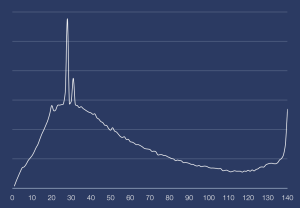I won the Listserve lottery, and sent this story out to about 13k people today. It was a revision of something I’d written a while back.
Patrick of Ireland
Once upon a time — and listen, for although this sounds like a fable, I will try to make every word true — once upon a time there was a young boy named Patrick, a young Christian boy whose father was a deacon, and whose grandfather was a priest. Patrick, though he was raised in a Christian household did not himself know God. I imagine he was like most people, just living his life out without much concern for spiritual things.
But then something really terrible happened. Raiders attacked his parents’ villa, and Patrick was taken off to be a slave in Ireland. I suspect that his parents had plans for him to go off to the city to become an educated gentleman. Instead, he was taken off at age sixteen to become a slave. Instead of going to school, he was forced to become a shepherd.
In his loneliness and emptiness, he began to remember what he knew about God. And he started to pray the prayers he had been taught; I don’t know what prayers, but I imagine he prayed the “Our Father.” He started praying more and more — in the fields at night and during the day, even waking up before daylight to pray, praying up to, he says, 100 prayers in a day. God started to burn in him.
He was a slave until he was about twenty, and then something very spooky but real happened. He was sleeping, but he heard a voice saying he was going home soon. Soon after he heard the voice again saying that his boat was ready. He immediately fled from his slave-owner, for he recognized that this was a message directly from God. He had to travel 200 miles to get to the harbor where the ship was, in a land he did not know, among people whom he did not know.
He found the ship, and they almost didn’t take him. After the visions and after walking 200 miles, I imagine he was disappointed. He headed back to the hut where he was staying praying along the way. As he was walking and praying, one of the men shouted at him to come back; he could get a ride with them.
They traveled for three days before they landed, and then the whole group started walking — after twenty-eight days, their food ran out, and it was uninhabited. His companions were kind to have taken him in, but now they were hungry and cranky, and began to taunt him about God, asking that perennial question: If God is so great and powerful, why isn’t God helping us?
Patrick had good reason to trust that God had something other than starving in mind for them, though, and he told them boldly that they should become Christians. He also said that God was going to provide so much food that very day that they couldn’t eat any more. And so it happened: a herd of pigs came by, and I imagine they had a pretty good pork barbecue. Their attitude towards God and Patrick changed that day; in fact, they had fire and food enough for the rest of their journey.
Patrick eventually was able to return to his kinsfolk, and he was glad to return, and they were glad to have him. But Patrick had another dream: a man named Victorius bringing letters from Ireland, and in his dream he read one of the letters. The letter said it was “The Voice of the Irish,” and he could hear the voices of people he knew in Ireland begging him to return to return to the land of his slavery.
So Patrick returned to Ireland to preach. He didn’t cast out the snakes; we don’t know if he used a shamrock to teach the Trinity; the hymns attributed to him are most likely not by him. But we know he continued to face hardship. In fact, he was kidnapped at least one more time for two months. Patrick’s life was full of ups and downs, He was ashamed of his poor education (poor man, he only knew three or so languages and wrote his confession in Latin that was perhaps not up to par). He called himself a stutterer, though he preached to thousands. He felt that “poverty and failure suited him better than wealth and delight.” He certainly never got wealthy ministering to the Irish. He remained homesick, I think, to the end of his days. But he recognized the work of God through him, but he felt bound by the Spirit to remain in Ireland.

